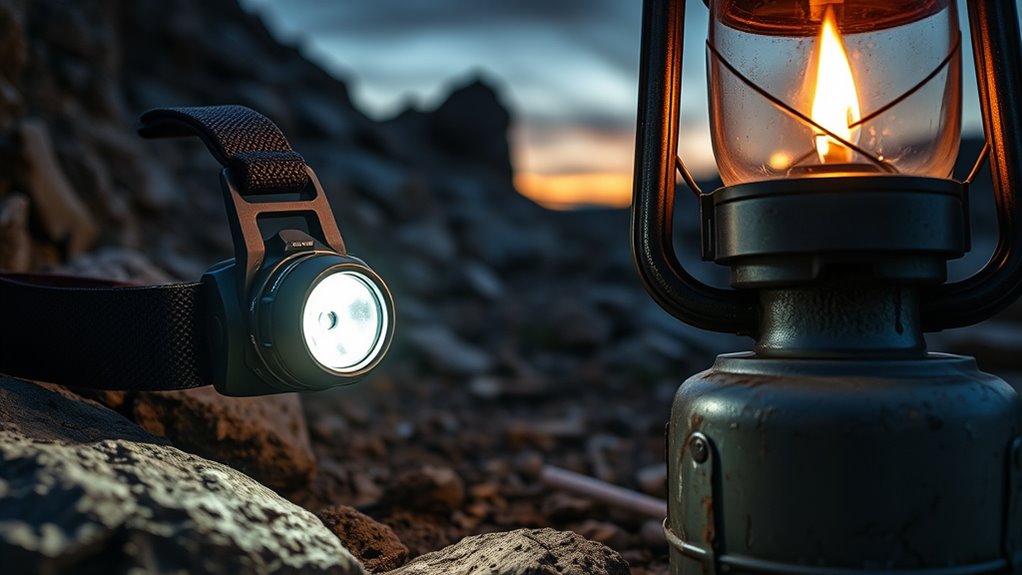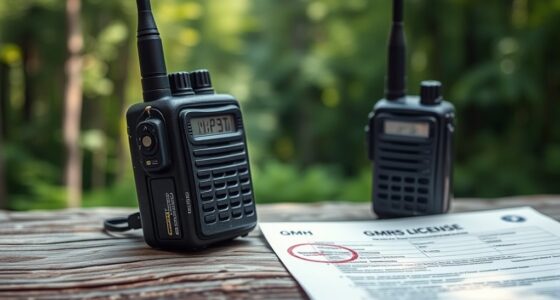To avoid hidden costs when choosing between headlamps and lanterns, consider their power consumption, durability, and versatility. Headlamps are usually more energy-efficient and last longer, cutting down on battery replacements. Lanterns tend to be bulkier and consume more power, leading to higher ongoing expenses. Investing in high-quality, durable models and maintaining them properly can save money over time. If you want to learn more about these hidden costs and how to manage them, keep exploring this guide.
Key Takeaways
- Prioritize energy-efficient headlamps to reduce long-term battery replacement and power costs.
- Invest in durable, high-quality models to minimize frequent repairs and replacements over time.
- Consider use-case needs; headlamps offer portability, while lanterns provide broader illumination, affecting overall costs.
- Regular maintenance and proper handling extend device lifespan, preventing costly repairs and early replacements.
- Stay informed about technological advances to select energy-saving features that lower hidden operational expenses.
Hidden Battery Expenses and Power Consumption

While headlamps and lanterns may seem similar, their hidden battery expenses and power consumption can vary considerably. Headlamps often prioritize power efficiency, which extends battery lifespan and reduces how often you need to replace or recharge batteries. Their focused beams use less energy, making them more cost-effective over time. Lanterns, however, tend to consume more power because they distribute light over a broader area, shortening battery lifespan and increasing replacement costs. If you want to minimize hidden expenses, choose a headlamp with high power efficiency, ensuring longer battery life and fewer replacements. Recognizing these differences helps you plan your budget better and avoid unexpected costs, especially during extended outdoor trips or emergencies. Additionally, AI-driven solutions in technology are continuously improving energy efficiency standards for portable lighting devices, potentially lowering your long-term costs even further.
Durability and Replacement Costs Over Time

Durability considerably impacts the long-term costs of headlamps and lanterns, as more durable models require fewer replacements and repairs. The bulb lifespan plays a vital role; higher-quality bulbs tend to last longer, reducing replacement frequency. Material durability also matters—robust materials resist damage from drops, moisture, and rough handling, extending the overall lifespan of your lighting device. Investing in well-made models initially may cost more but saves money over time by decreasing the need for frequent replacements. Keep in mind that cheaper options often compromise on bulb lifespan and material quality, leading to hidden costs like frequent repairs or early disposal. Selecting durable headlamps or lanterns with strong materials and long-lasting bulbs helps you avoid ongoing expenses and guarantees reliable performance. Additionally, understanding creative practice principles can encourage innovative ways to enhance the durability or functionality of your lighting tools through DIY repairs or modifications.
Versatility and Usage Limitations

Durability and material quality influence not just how long your headlamp or lantern lasts, but also how effectively it can be used across different situations. When considering versatility, beam angles are essential; headlamps often offer adjustable beams for focused task lighting or wide-area illumination, while lanterns typically provide 360-degree light. Weight considerations matter too—headlamps are generally lightweight and hands-free, ideal for movement, but may lack brightness or coverage. Lanterns can be bulkier, making them less portable but better for group settings or stationary tasks. Limitations include:
- Narrow beam angles limit wide-area coverage
- Fixed beam modes reduce adaptability
- Heavier lanterns can be cumbersome
- Headlamps may lack sufficient brightness for large spaces
- Limited options for multi-directional lighting
Choose based on your specific needs and environment. Recognizing and identifying angel numbers can help you better understand these limitations and make informed choices about lighting tools suited to your activities.
Maintenance and Upkeep Hidden Expenses

Maintaining your headlamp or lantern involves more than just replacing batteries; hidden expenses can quickly add up if you’re not careful. One overlooked cost is adjusting the lighting angle to guarantee proper illumination, which may require additional accessories or replacements over time. Poor weight distribution can cause wear and tear on mounting straps or batteries, leading to more frequent repairs. Additionally, misaligned lighting can result in inefficient use, prompting you to replace or upgrade equipment sooner than expected. Regular checks to keep the headlamp’s or lantern’s components in ideal condition help avoid costly replacements. Moreover, investing in durable materials for parts can reduce the frequency of repairs and replacements. By understanding these hidden expenses, you can better plan your maintenance routine and extend the lifespan of your gear, ultimately saving you money in the long run.
Frequently Asked Questions
Can Headlamps or Lanterns Be Used Effectively Underwater?
You can’t use regular headlamps or lanterns effectively underwater because they lack waterproof compatibility. For underwater illumination, look for gear specifically designed for aquatic use, such as waterproof headlamps or lanterns rated for submersion. These options guarantee safety and visibility underwater. Using equipment not intended for water can lead to damage, reduced performance, or safety hazards. Always choose waterproof gear to get reliable illumination beneath the surface.
What Is the Impact of Weather Conditions on Light Performance?
Weather conditions can drastically affect your light performance. Rain or fog scatters the beam, reducing visibility, especially if your headlamp or lantern has a narrow beam angle. Strong winds or snow can also diminish power output by draining batteries faster. You need to choose gear suited for these conditions, ensuring your beam angle is wide enough to illuminate obstacles, and your power output is reliable, so you stay safe and aware despite the weather’s unpredictable impact.
Are There Safety Concerns With Rechargeable Versus Disposable Lights?
You should be aware that rechargeable lights can pose safety concerns like battery corrosion, which might damage the device or cause leaks, and fire hazards if not properly maintained or charged. Disposable lights eliminate these risks but contribute to environmental waste. Always follow manufacturer instructions, regularly check for corrosion, and avoid overcharging to guarantee safe use regardless of the type you select.
How Do Different Terrains Affect Lighting Choices and Costs?
Think of terrain as a wild river shaping your journey; it influences your lighting needs and costs. On rugged terrain, you’ll need brighter, durable lights, which can increase costs and battery consumption. Flat, predictable paths require less powerful options, saving money. Terrain variability directly impacts your choice of headlamps or lanterns, as more challenging landscapes demand more robust gear, leading to higher initial and replacement costs. Planning ahead helps you avoid surprises.
What Hidden Costs Are Associated With Emergency Lighting Scenarios?
In emergency lighting scenarios, you might overlook costs like battery lifespan and maintenance expenses. Batteries can degrade over time, requiring replacements that add up, while maintenance guarantees your lights stay functional when needed. Failing to account for these hidden costs can lead to unexpected expenses during emergencies. Regular checks and choosing reliable equipment can help you avoid costly replacements and maintain effective lighting when it matters most.
Conclusion
Now that you know the hidden costs of headlamps and lanterns, are you ready to choose the best lighting for your needs? Consider not just the upfront price but also battery expenses, durability, versatility, and maintenance. Will you prioritize long-term savings or immediate convenience? By understanding these hidden expenses, you can make smarter decisions that light up your adventures without draining your wallet. After all, isn’t saving money and avoiding surprises what good planning’s all about?









